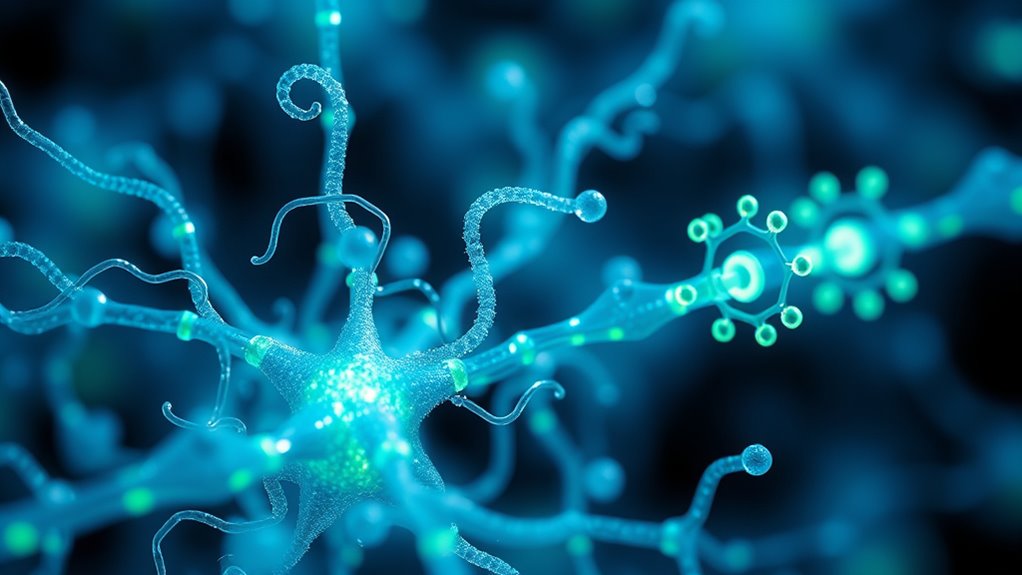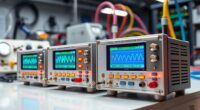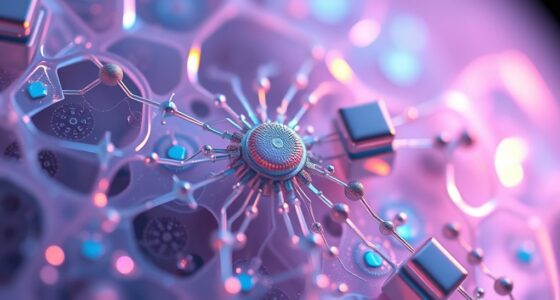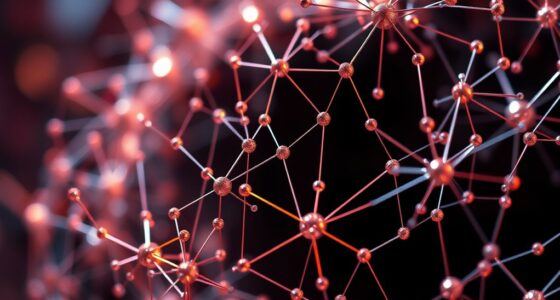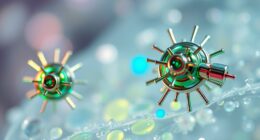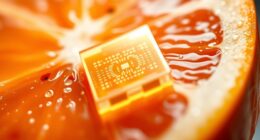Nature’s nanomachines like kinesin and ATP synthase teach you about highly efficient energy use and precise motion at tiny scales. Kinesin walks along microtubules by converting ATP into mechanical work, while ATP synthase spins to produce energy from proton flow. These biological systems showcase design principles such as self-assembly, conformational shifts, and directional movement. Understanding their intricacies offers valuable lessons for creating artificial nanodevices; if you explore further, you’ll uncover how these ideas shape future innovations.
Key Takeaways
- Natural nanomachines demonstrate efficient energy conversion through conformational changes and rotational motion, guiding artificial nanodevice design.
- Kinesin’s unidirectional, ATP-driven movement offers insights into creating targeted, energy-efficient transport systems at the nanoscale.
- ATP synthase’s proton-driven rotation illustrates how electrochemical gradients can be harnessed for mechanical work in synthetic nanomachines.
- Principles like modularity, self-assembly, and minimal energy use from biological systems inform scalable, adaptable nanotechnology development.
- Studying these nanomachines highlights key features such as directionality and conformational dynamics vital for designing functional artificial nanodevices.
The Structure and Function of Kinesin
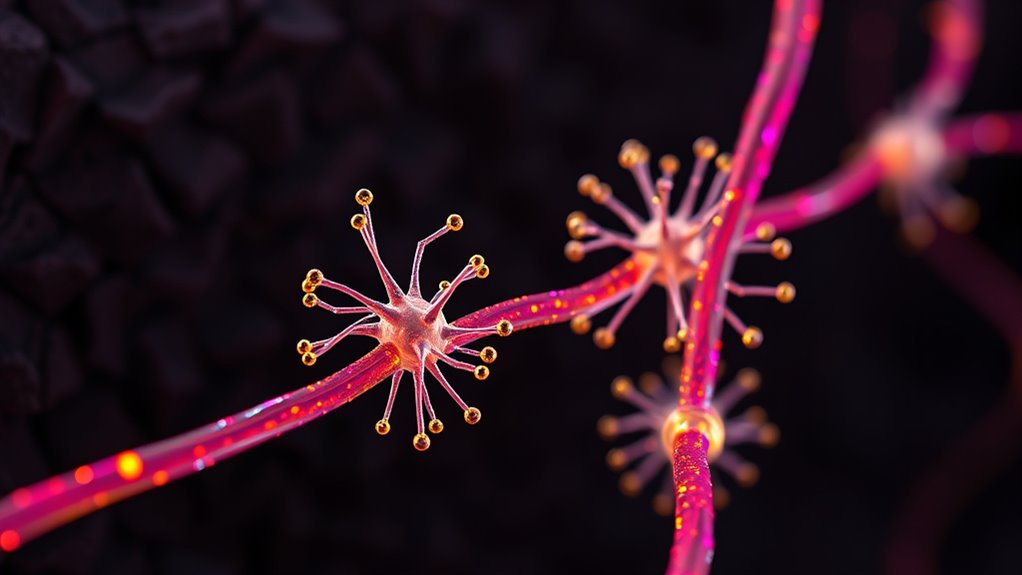
Have you ever wondered how cells transport their cargo so efficiently? It all comes down to the remarkable structure of a molecular motor called kinesin. This protein acts like a tiny engine, converting chemical energy from ATP into mechanical work. Kinesin has two motor domains that “walk” along microtubules, essentially serving as tracks within the cell. Its tail attaches to various cargo, such as vesicles or organelles, enabling targeted cellular transport. As kinesin moves, it takes powered steps, ensuring rapid and precise delivery. This efficient system keeps cells functioning smoothly, supporting everything from nutrient distribution to waste removal. Understanding kinesin’s structure and function reveals how nature engineered these sophisticated nanomachines for crucial cellular processes. Data-driven strategies can further optimize our understanding of such molecular mechanisms.
Mechanisms of Cargo Transport by Kinesin
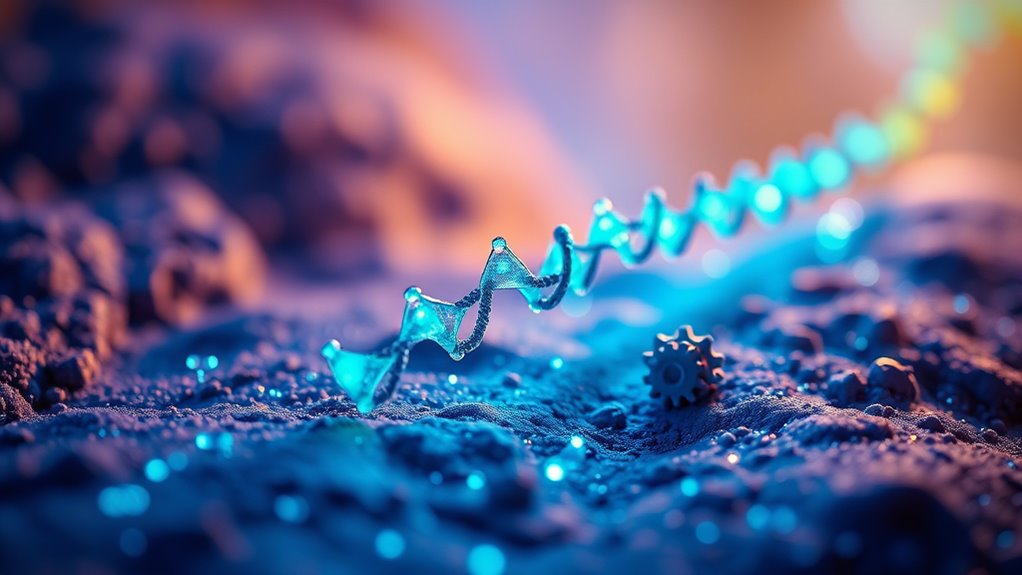
You can think of kinesin moving cargo through a step-by-step process, where each step brings it closer to its destination. ATP hydrolysis provides the energy needed for these movements, fueling each step’s power stroke. Understanding this mechanism reveals how kinesin converts chemical energy into mechanical work efficiently. Additionally, the process is highly regulated by cellular signals, ensuring precise cargo delivery within the cell.
Stepwise Movement Process
Kinesin moves along microtubules through a precise, stepwise mechanism driven by ATP hydrolysis. Each step involves coordinated conformational changes that enable cargo transport, essential for molecular signaling and cellular communication. This process guarantees efficient delivery of organelles and molecules, maintaining cellular function. As kinesin steps forward, it converts chemical energy into mechanical work, guiding cargo accurately through crowded environments. The cycle involves binding ATP, causing the rear head to detach and swing forward, then hydrolyzing ATP to reset for the next step. This regulated movement exemplifies the intricate design of biological nanomachines. Understanding this stepwise process reveals how kinesin achieves high specificity and precision in intracellular transport, inspiring nanodevice development. The mechanism highlights the elegance of nature’s solutions to complex cellular communication challenges.
ATP Hydrolysis Role
ATP hydrolysis provides the chemical energy that powers kinesin’s movement along microtubules. As a key molecular motor, kinesin converts this energy through energy transduction, enabling it to walk processively along microtubule tracks. During each step, ATP binds to kinesin’s motor domain, triggering hydrolysis that releases energy. This energy causes conformational changes in the motor protein, translating chemical energy into mechanical work. The cycle of ATP binding, hydrolysis, and product release ensures continuous cargo transport. Without ATP hydrolysis, kinesin cannot sustain its movement, highlighting its essential role in fueling molecular motors. This process exemplifies how biological systems harness chemical energy to produce directed mechanical motion, inspiring nanomachines that emulate efficient energy transduction mechanisms seen in nature.
The Energy Conversion Process of ATP Synthase
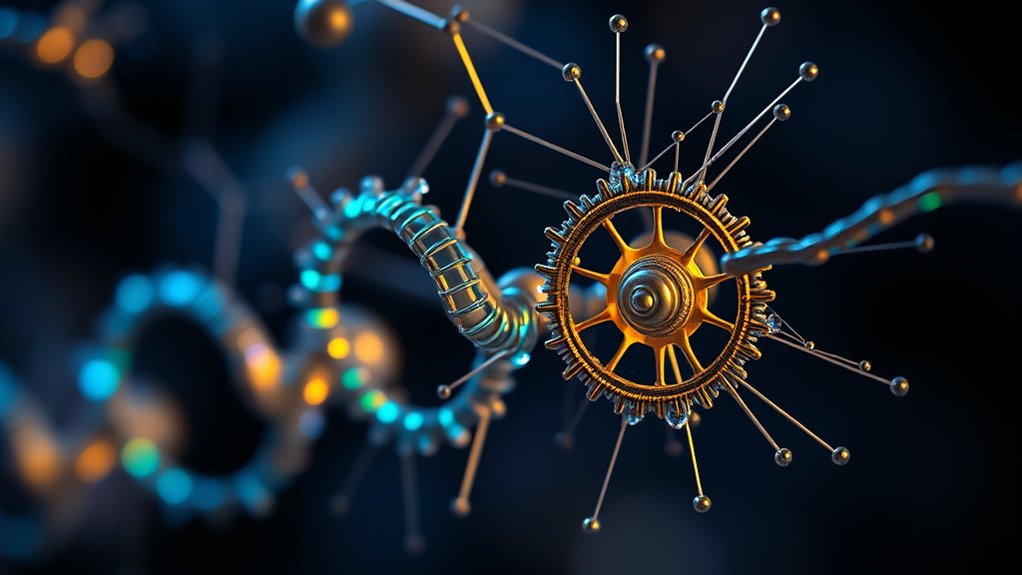
You observe how proton flow through ATP synthase drives its rotation, converting chemical gradients into mechanical energy. This rotary motion transfers energy efficiently, enabling the enzyme to synthesize ATP. Understanding this process reveals how nanomachines harness energy with remarkable precision. best practices in energy conversion are exemplified by ATP synthase’s highly optimized mechanism.
Proton Flow Mechanics
How does proton flow drive the energy conversion process in ATP synthase? When protons pass through the enzyme’s membrane-embedded channel, they cause a conformational change that powers ATP synthesis. This flow is tightly regulated, linking molecular signaling to ensure efficient energy transfer. Proton movement isn’t just about ATP; it also influences processes like membrane fusion, essential for cellular communication. As protons travel down their gradient, they generate torque that spins the enzyme’s rotor, transforming electrochemical energy into chemical bonds. This mechanism exemplifies nature’s nanomachines working seamlessly. Understanding proton flow mechanics reveals how tiny particles control large-scale biological functions and inspire nanotechnological innovations. Key aspects include proton gradient formation, channel structure, energy transduction, molecular signaling pathways, and the enzyme’s rotational dynamics.
Rotary Energy Transfer
The rotary energy transfer process in ATP synthase is a remarkable example of biological nanomachines converting electrochemical energy into chemical bonds. As a molecular motor, ATP synthase harnesses proton flow to induce rotation in its central shaft. This rotation is a critical step in energy transduction, transforming the electrochemical gradient into mechanical motion. The spinning of the motor drives conformational changes in the enzyme’s catalytic sites, enabling the synthesis of ATP from ADP and inorganic phosphate. You can think of this process as a finely tuned rotary engine, where energy from proton flow is directly converted into the chemical energy stored in ATP. This efficient energy transduction exemplifies nature’s mastery of nanoscale engineering, inspiring innovations in artificial nanomachines.
How Kinesin Achieves Directional Movement

Kinesin achieves its directional movement through a carefully coordinated process driven by ATP hydrolysis and structural changes within its motor domains. This precision guarantees it moves unidirectionally along microtubules, exemplifying the high directional fidelity of molecular motors. The stepping mechanism involves the binding and hydrolysis of ATP, causing conformational shifts that propel kinesin forward. Its ability to maintain directionality relies on asymmetric structural features that prevent backward movement. These features enable kinesin to convert chemical energy into mechanical work efficiently, critical for intracellular transport. Understanding how kinesin attains such directional fidelity reveals insights into nanoscale precision. Structural asymmetry prevents backward slips.
The Rotary Motion of ATP Synthase
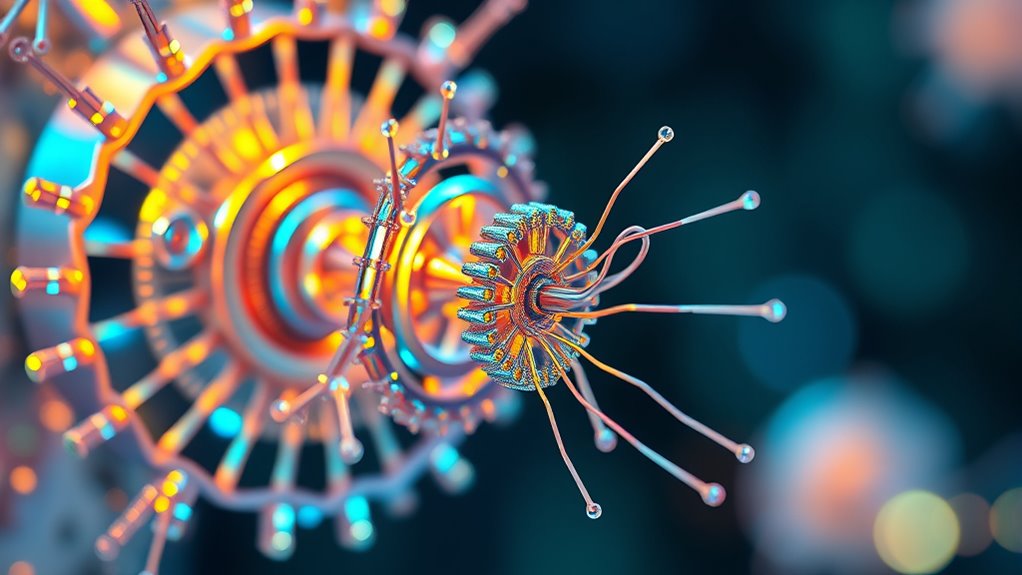
Have you ever wondered how ATP synthase converts energy into a usable form? Its rotary motion is a marvel of molecular dynamics, driven by proton flow through the enzyme’s membrane. As protons pass, they cause the central rotor to spin, turning mechanical energy into chemical energy. Researchers use synthetic modeling to replicate this motion, helping us understand its efficiency and precision. The rotation occurs in discrete steps, each powered by proton translocation, showcasing nature’s intricate design. By studying these molecular dynamics, scientists gain insights into how nanoscale machines operate reliably. This rotary mechanism not only highlights nature’s engineering prowess but also informs the development of artificial nanomachines inspired by ATP synthase’s elegant energy conversion. Additionally, understanding the underlying units of measurement helps researchers quantify and compare the efficiency of these molecular systems.
Mimicking Natural Nanomachines: Design Principles
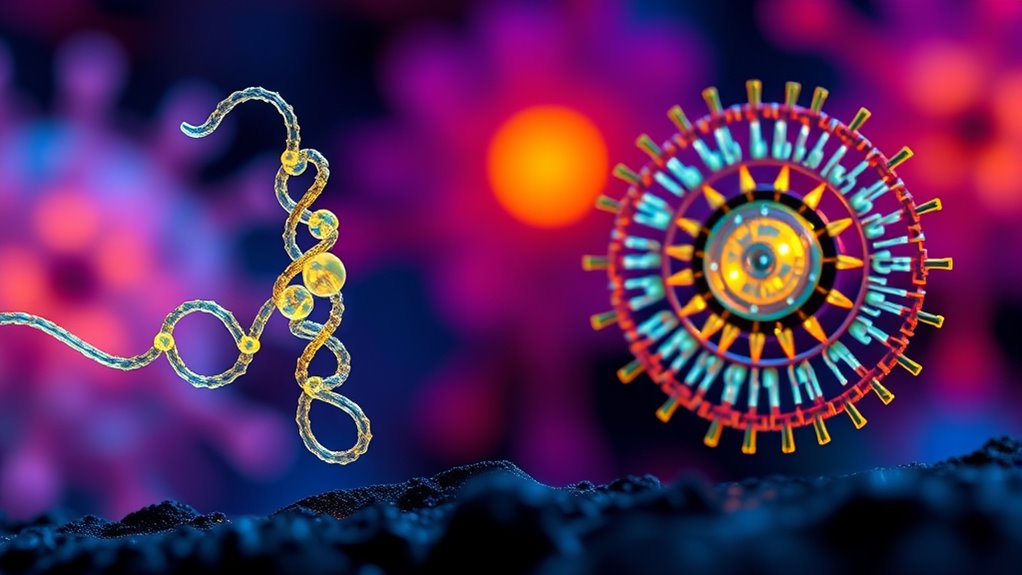
Nature’s nanomachines exemplify efficiency and precision, providing clear design principles for artificial counterparts. To mimic these systems effectively, focus on key features like modularity, self-assembly, and energy efficiency. When designing artificial materials, prioritize biocompatibility and adaptability to replicate natural functions. Keep in mind that scalability challenges often arise; creating nanomachines that work reliably at larger scales remains tough. Emphasize robustness and simplicity in your designs to improve manufacturability. Studying natural nanomachines teaches you to harness conformational changes, precise binding, and directional motion. These principles guide you in developing functional nanodevices that can operate with minimal energy, high specificity, and integrated complexity. Applying these insights helps bridge the gap between biological inspiration and practical, scalable nanotechnologies. Additionally, understanding the aesthetic aspects of natural nanomachines can inspire more intuitive and user-friendly designs for artificial systems.
Challenges in Developing Synthetic Nanomachines
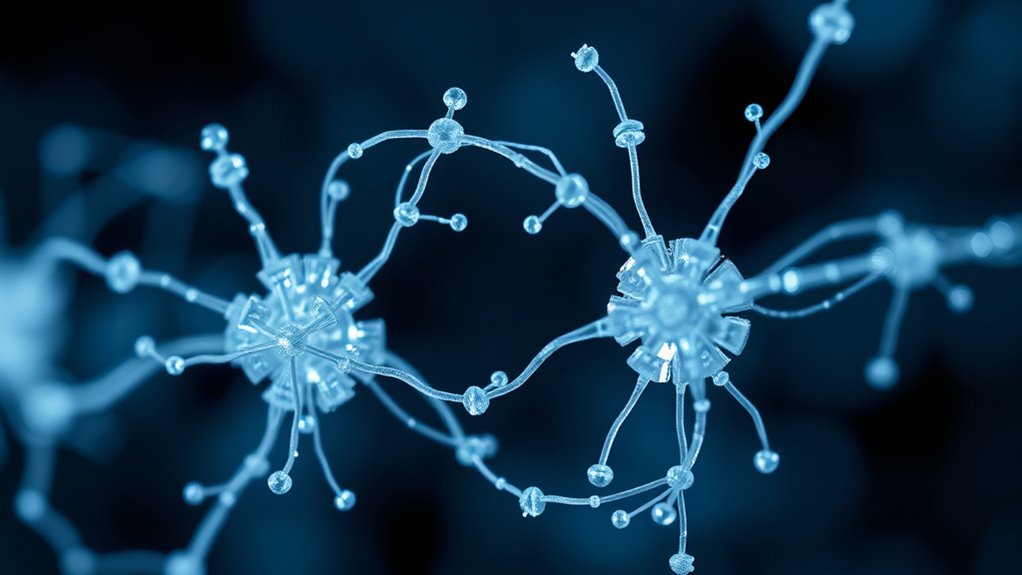
Developing synthetic nanomachines faces significant hurdles due to the intricacy of mimicking biological functions at such a microscopic scale. You must select suitable synthetic materials that mimic natural flexibility and durability. Scalability challenges arise because creating functional devices in lab conditions doesn’t easily translate to mass production. Achieving precise control over movement and interactions remains difficult, often resulting in unpredictable behavior. Imagine this challenge visually:
| Synthetic Material | Functionality |
|---|---|
| Nanopolymer | Flexibility and strength |
| Nanoalloy | Conductivity and resilience |
| Biocompatible Coatings | Compatibility with biological environments |
These materials must work seamlessly together, but replicating the efficiency and adaptability of natural nanomachines is a formidable task. Overcoming these challenges requires innovative approaches to material design and manufacturing processes, especially in understanding biological mechanisms that inspire synthetic solutions.
Potential Applications in Medicine and Industry
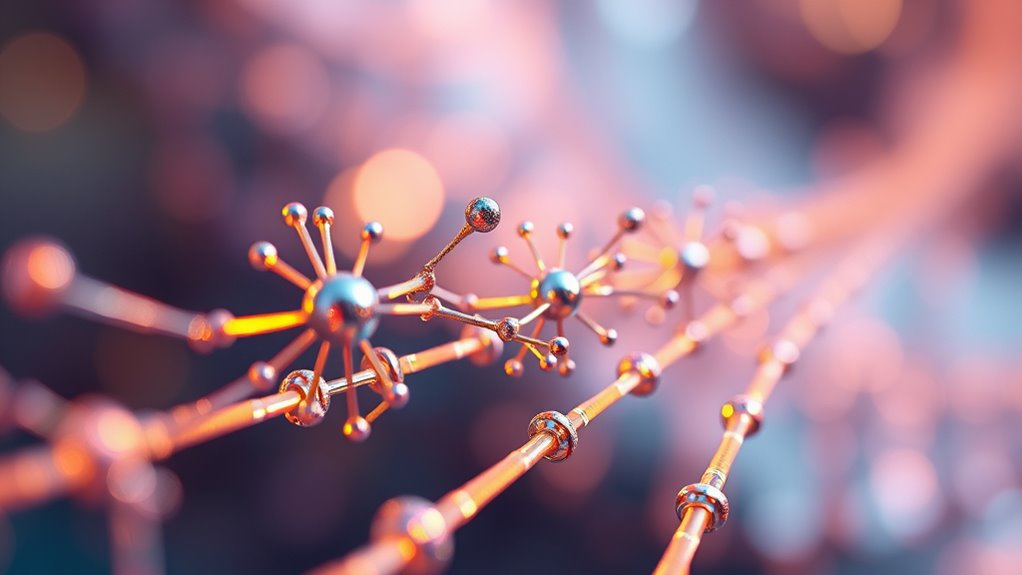
Nanomachines hold immense promise for revolutionizing medicine and industry by enabling precise, targeted interventions at the cellular and molecular levels. In biomedical engineering, they can deliver drugs directly to affected cells, reducing side effects and increasing treatment efficacy. In industrial manufacturing, nanomachines can assist in assembling complex materials with atomic precision, improving product quality and efficiency. Potential applications include targeted cancer therapies, nanoscale sensors for diagnostics, and self-assembly processes in electronics. They could also revolutionize drug discovery by enabling rapid screening at the molecular level and enhance environmental monitoring. Additionally, understanding the divorce process in various states can inspire the development of complex systems that adapt to legal and social frameworks. These advancements open doors for safer, more efficient healthcare solutions and smarter manufacturing processes, transforming both fields through innovative nanotechnologies inspired by nature’s nanoscale machinery.
Future Directions in Bio-Inspired Nanotechnology

As research advances, the future of bio-inspired nanotechnology looks promising, with new strategies emerging to mimic and enhance biological processes at the nanoscale. Quantum effects are increasingly recognized as essential in designing more efficient nanomachines, enabling precise control and energy transfer at the atomic level. Researchers are exploring synthetic biomimicry to replicate complex biological functions, pushing the boundaries of what’s possible in nanodevice engineering. By integrating quantum phenomena, future nanomachines could achieve unprecedented performance, such as enhanced sensitivity or energy efficiency. Advances in nanotechnology will likely lead to smarter, more adaptable systems that better emulate natural machinery. As you explore this field, you’ll see how combining quantum effects with innovative synthetic biomimicry paves the way for groundbreaking applications in medicine, manufacturing, and environmental science.
Frequently Asked Questions
How Do Kinesin Molecules Know Their Specific Cargo?
You might wonder how kinesin molecules recognize their specific cargo. They do this through cargo recognition, which involves molecular signaling. Special adaptor proteins or receptors on the cargo surface interact with kinesin’s binding sites, ensuring accurate attachment. This precise molecular signaling guides kinesin to its target, allowing it to transport cargo efficiently along microtubules, maintaining cellular organization and function.
What Are the Main Limitations of Current Synthetic Nanomachines?
You’re hitting a wall with current synthetic nanomachines because of scalability challenges and energy source limitations. These tiny devices often can’t operate efficiently at larger scales or in complex environments. Their power sources, like chemical fuels or external stimuli, aren’t always reliable or sustainable. As a result, they struggle to match the versatility and endurance seen in natural counterparts, making widespread, practical applications a real uphill battle.
How Does Temperature Affect ATP Synthase Efficiency?
Temperature impacts ATP synthase efficiency by affecting its thermal stability and enzyme kinetics. As temperature rises, the enzyme’s activity may increase up to a best point, enhancing ATP production. Beyond that, too high temperatures can destabilize the enzyme’s structure, reducing efficiency. Conversely, lower temperatures slow down enzyme kinetics, decreasing ATP synthesis. Maintaining an ideal temperature ensures maximum efficiency and stability of ATP synthase function.
Can Kinesin Operate in Non-Biological Environments?
You might think kinesin is strictly biological, but with synthetic adaptation, it can operate in non-biological environments—if you can overcome environmental constraints. Imagine a tiny motor dragging cargo through a vacuum or salty ocean, defying nature’s limits. Though challenging, engineers are exploring such possibilities, pushing kinesin beyond cells. So yes, kinesin can work outside biology, but only with clever design and a bit of irony in its resilience.
What Are the Ethical Considerations in Designing Artificial Nanomachines?
When designing artificial nanomachines, you need to contemplate biosafety concerns to prevent unintended harm to living systems and the environment. You must also weigh moral implications, such as potential misuse or ethical dilemmas around autonomy and control. Ensuring transparency, regulation, and responsible innovation helps address these issues, guiding you to develop nanomachines that benefit society without risking safety or crossing ethical boundaries.
Conclusion
So, now you know that mimicking nature’s tiny tech geniuses isn’t just about copying—they’re practically giving us master classes in efficiency. Kinesin and ATP synthase prove that if you want your nanomachines to work smoothly, maybe stop reinventing the wheel and start paying attention. Who knew that the secret to futuristic gadgets was hiding in your cells all along? Perhaps it’s time to thank biology—and maybe, just maybe, let it do the heavy lifting.
